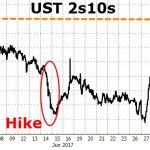
The US dollar is mostly little changed against the major currencies. The chief exception is the yen. Its apparent purchases on the crosses succeeded in pushing the dollar from near JPY120.50 to almost JPY119.80. Lower US bonds yields and falling stocks in Europe may have been the trigger in an otherwise light news session. Recall Tokyo markets remain closed and will re-open Thursday.
Asian equity markets were mixed. Australia, China, Hong Kong, Taiwan, and South Korea gained, while bourses that are open later, into the European session, like India, Thailand and Malaysia fell. European shares are sliding lower today. Commodity producers are leading the Dow Jones Stoxx 600 2.0% lower. US shares are also trading heavy in Europe; warning of a 1.5% lower opening.
Falling equities and heavier commodity prices the main force behind the lower Treasury and European bond yields, which are 2-4 bp lower. Spanish and Portuguese bonds are exceptions, and yields are up slightly.
The news stream is particularly light. The main driver appears to be position adjustments after the dollar recovery from the disappointment with last week’s Fed decision, and ahead of this week’s key events which include ECB President Draghi’s testimony before the European Parliament tomorrow and Yellen’s speech at Amherst at the end of the week.
Four regional Fed Presidents (Atlanta, San Francisco, St. Louis, and Richmond have all reiterated that likelihood of a rate hike before the end of the year. We had drawn parallels between the Fed’s tapering and lift-off. The Fed began preparing the market for tapering. Hence the taper tantrum. While many (though not us) expected the tapering to be announced in September 2013. the Fed waited until December as if giving investors (and itself) more time.
Many are thinking of a repeat. October is being largely shunned. First, there is the awkwardness of having to call an impromptu press conference, which, while theoretically possible (and the media has some guidelines on how this would work), may be undesirable operationally, especially for the first move. Second, there is a sense that the reasons the Fed gave for not going (essentially two: China and low market-based inflation expectations) last week may not have changed very much by the end of October.












Leave A Comment